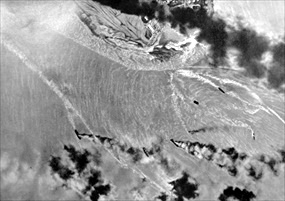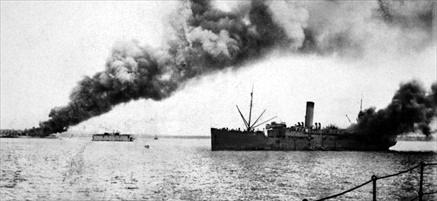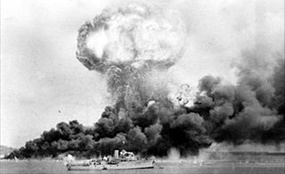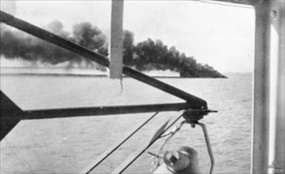ADM. YAMAMOTO ORDERS AIR RAID ON DARWIN
Tokyo, Japan • February 9, 1942
On December 8, 1941, the U.S. Congress declared war on the Empire of Japan in response to the massive Japanese attack on the U.S. Pacific Fleet anchored at Pearl Harbor, Hawaii. That same December day and the next the governments of Great Britain, Canada, China, and Australia declared war on Japan. From December 22 and continuing well into January 1942, U.S. President Franklin D. Roosevelt played host to British Prime Minister Winston Churchill in the nation’s capital, Washington, D.C. The 2 statesmen and their top military leaders and aides took a series of major decisions that shaped the Allies’ 2‑theater war effort into 1943. One of the immediate tactical decisions of their Arcadia Conference was the creation, on January 1, 1942, of a unified American-British-Dutch-Australian Command (ABDACOM) in the Far East, where both the British and Dutch possessions, the latter with crucial oil and rubber resources, were already under siege by surging Japanese military forces.
The 4 allies established their main supply base at the strategic Australian port of Darwin, capital and largest settlement in the sparsely settled Northern Territories. Already Darwin was home to airfields, training bases, maintenance facilities, fuel and munitions storage, and air and sea communications in the South and Central Pacific. By February 1942 the town (reduced to 2,000 souls) was an important Allied base in the defense of the multi-island Netherlands East Indies (now Indonesia). The islands of Celebes (Sulawesi) and Borneo (Kalimantan) due north of Australia had fallen to Japanese invaders, and NEI’s Timor and Java to Australia’s northwest were in Japan’s crosshairs as its military advanced through Southeast Asia. On this date, February 9, 1942, Adm. Isokoru Yamamoto, commander in chief of the Japanese Combined Fleet and the architect of the surprise December 7, 1941, attack on Pearl Harbor, ordered air strikes on Darwin to render its offensive facilities useless against Japan’s planned seizure of Timor and Java, the latter island the site of the Dutch administrative capital, Batavia (today’s Jakarta). Ten days later Japanese aircraft set out to obliterate Darwin in the first air strike on the Australian continent.
On February 19, 1942, 188 Japanese carrier and 54 land-based planes, in 2 separate raids, attacked Australian and U.S. naval and merchant ships in Darwin’s harbor as well as aircraft and hangers at the town’s military and civil airstrips, plus the town’s hospital, post office, and police barracks. Operating in the Timor Sea less than 250 miles/400 kilometers northwest of Australia, 4 of the 6 Japanese flattops that had participated in the Pearl Harbor assault—commander Vice Adm. Chūichi Nagumo reprising his December 1941 role—were present for the Darwin raid. Incoming enemy raiders, just as was the case at Pearl Harbor, were misidentified as friendly aircraft, so no alarm was sounded before 4 of 5 defending Royal Australian Air Force Curtiss P‑40B Tomahawk fighters were blown out of the sky. Only when enemy warbirds hurled themselves at their first targets in the busy harbor did sirens sound.
The day’s second wave of raiders was made up of land-based medium bombers that pummeled Darwin at mid‑day. This high-level bombing inflicted extensive damage on the 2 airbases. Between the 2 February 19 air raids, the Japanese caused 243 and possibly 320 civilian and military deaths (some victims while parachuting from their stricken aircraft) and wounded between 300 and 400, destroyed 30 Australian and U.S. aircraft on the tarmac and in the air, sank 11 vessels and damaged 25 others, and destroyed most of Darwin’s civil and military facilities. Sixty-three more enemy air raids would be directed against Darwin and more than 100 air raids against Northern Australian towns during 1942–1943. (Sydney and Newcastle, cities in New South Wales, were attacked by Japanese submarines.) However, none of the air raids matched the scale, ferocity, destruction, or inflicted the chaos of the February 19 Battle of Darwin.
Obliterating Darwin, February 19, 1942
 |  |
Left: Thirty-nine-year-old Naval Commander Mitsuo Fuchida, who directed the first wave of Japanese planes over Pearl Harbor on December 7, 1941, and led the first wave over Darwin nearly 2½ months later, recalled the town “harbor was crowded with all kinds of ships which we picked off at our leisure.” The majority of the 65 vessels riding at quite anchor belonged to the Royal Australian Navy (one being the AHS Manunda, a hospital ship that was badly damaged in the raid in spite of sporting highly prominent red cross markings), 3 belonged to the U.S. Navy (1 destroyer sunk and a cargo vessel and a seaplane tender damaged), while about a dozen were merchantmen of varying sizes. More bombs were dropped on Darwin on February 19, 1942, than on Pearl Harbor, diminishing Darwin’s role as a naval port but not as an air base.
![]()
Right: Smoke billows from the Australian troopship SS Zealandia hit by a bomb and cannon and machine gun fire from Japanese long-range Mitsubishi G3M “Nell” and G4M “Betty” bombers flying from 2 captured bases in the Netherlands East Indies; 142 out of 144 men survived the February 19, 1942, assault on the troopship. The MV Neptuna, which was launched in 1924 and saw service in the merchant marine fleets of Germany and Australia, blazes at Darwin’s single wharf in the distance. Zealandia and Neptuna were among 9 ships sunk and 10 others damaged in the initial aerial wave over Darwin, which lasted 32 minutes.
 |  |
Left: A catastrophic explosion heralds the end of the MV Neptuna as clouds of smoke rise from on‑shore oil storage tanks. Hit near the stern while carrying a cargo of depth charges, TNT, and other armaments, the hapless Neptuna blazed fiercely before exploding, then turning on its side and taking the lives of 45 crewmen and dockhands while seriously injuring many others with showered debris. In the foreground is HMAS Deloraine, a convoy escort and antisubmarine patrol corvette that escaped unscathed and assisted in rescue and recovery operations. The U.S. cargo vessel Admiral Halstead (not pictured), carrying 8,000 drums of aviation gasoline, was strafed and damaged in the raid, its precious cargo rescued. The Australian government, concerned about the effect of the bombing on national morale, played down the Darwin raid for decades to come. A fictionalized version of the period received mixed reviews in the 2008 historical drama film Australia, starring Nicole Kidman and Hugh Jackman.
![]()
Right: Caught in the raid on the Cavite Navy Yard, Philippines, on December 10, 1941, the U.S. Navy Clemson-class destroyer USS Peary escaped to Darwin, arriving in January 1942. On February 19, 1942, the Peary was attacked 5 times by Japanese dive bombers. The fourth bomb set off the forward ammunition magazine. Lost with the ship were 88 officers and men, about half of the military victims who perished in the bombing of Darwin. The Peary was the first destroyer of the U.S. Asiatic Fleet (soon to be dissolved and incorporated into the U.S. Seventh Fleet) to be sunk in World War II.
The February 19, 1942, Bombing of Darwin, Australia
![]()

 History buffs, there is good news! The Daily Chronicles of World War II is now available as an ebook for $4.99 on Amazon.com. Containing a year’s worth of dated entries from this website, the ebook brings the story of this tumultuous era to life in a compelling, authoritative, and succinct manner. Featuring inventive navigation aids, the ebook enables readers to instantly move forward or backward by month and date to different dated entries. Simple and elegant! Click
History buffs, there is good news! The Daily Chronicles of World War II is now available as an ebook for $4.99 on Amazon.com. Containing a year’s worth of dated entries from this website, the ebook brings the story of this tumultuous era to life in a compelling, authoritative, and succinct manner. Featuring inventive navigation aids, the ebook enables readers to instantly move forward or backward by month and date to different dated entries. Simple and elegant! Click 











